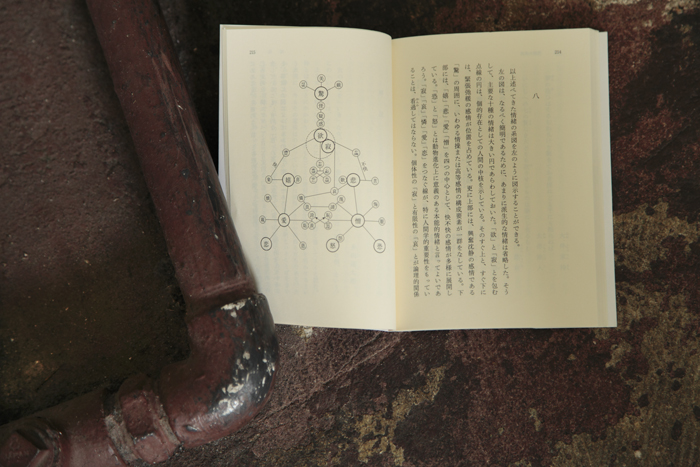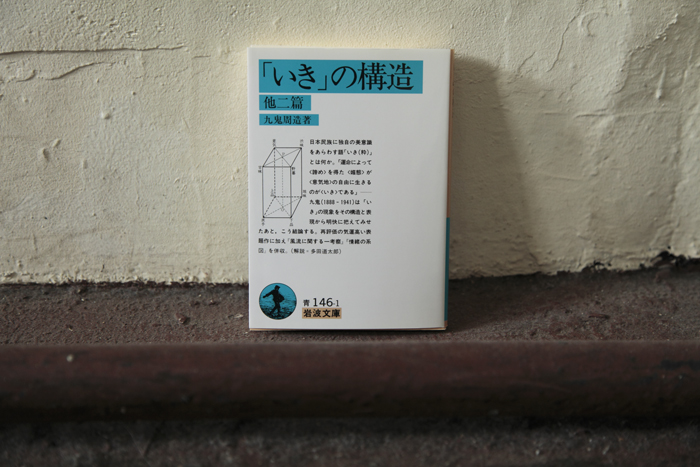神田須田町に立地する「松栄亭」は、明治40年に創業した洋食レストランの老舗です。「洋風かき揚げ」がお店の代名詞として知られていて、数々の文人に愛されてきまた。この料理は、初代店主の堀口岩吉が、東京帝国大学のケーベル博士の専属シェフをしていた頃に考案されました。夏目漱石が予告なしにケーベル邸を来訪した際、冷蔵庫の中の肉と鶏卵を出し、小麦紛をつなぎにして塩味をつけ、フライにして出したのが起源といわれています。「松栄亭」では、明治のその味を、いまでも堪能できるというわけです。
私が、この薀蓄を手にしたのは20歳のころ、当時お付き合いしている女性と「松栄亭」を訪れるためでした。逸話を口にしながら、御茶ノ水駅から松栄亭に向かった私は、完全に知ったかぶりでした。若い私には、会話に詰まることの方が怖かったのです。
しかし、その女性とのご縁は、残念ながら、ながくは続きませんでした。別れ際、恋愛には終わりがあるという定めを理解できていなかった私は、「まだ、気持ちの整理がつかない」とか、とても人前では言えないような言葉を連発して、引きとめにかかったのです。
野暮の極みとはこのことでした。こんなところで、ねばりをみせても仕方がないのです。A子さん、これを見ていたら、どうか許してやってください。いまは、今回紹介する『いきの構造』を読んで、洗練された大人になったつもりです。
『いきの構造』は、哲学者の九鬼周造により昭和5年に刊行されました。西洋文化一辺倒だった明治以来の日本において、日本の独自性を「いき」に求め、媚態、意気地、諦めの三要素から解説しています。媚態とは、異性への距離をできる限り接近させつつも交わらない甘美。意気地とは、恋心のままに動かされて、相手の虜になってしまうことのない気位。諦めとは、未練・執着のない心構え。独断と偏見ですが、九鬼周造は、このように解いたと思われます。
ちなみに、九鬼周造は、ケーベル博士の門下生だったので、きっと「洋風かき揚げ」を食べたことでしょう。あのころの自分に『いきの構造』を教えてやりたいです。
 PHOTOGRAPHY BY KAZUO MINATO
PHOTOGRAPHY BY KAZUO MINATO
Shoeitei located in Kanda-Sudacho is a long-standing Western-style food restaurant built in the 40th year of Meiji (1907). Its Western-style Kakiage is synonymous with the restaurant, which has been loved by numerous men of letters. The food was thought up when the original owner, Iwakichi Horiuchi, worked as an exclusive chef for Professor Koeber of Tokyo Imperial University. He was said to have come up with it when he took meat and chicken eggs from the refrigerator, thickening wheat flower, salting and then frying it to serve when Natsume Soseki visited Koeber's residence unannounced. At Shoeitei, you can still have your fill of the Meiji flavor.
I came upon this great knowledge when I was 20 by visiting Shoeitei with a girl I was dating at the time. I was a complete know-it-all, heading to Shoeitei from Ochanomizu station while telling her an anecdote. In my youth, I was afraid of having nothing to talk about.
However, my relationship with her did not, unfortunately, last long. When we broke up, I didn't understand that in love it is a rule that there is an end. I tried to keep her, saying things one could never say in front of people like, “I still just don't know how you feel.”
This was the zenith of non-Iki. It's no use trying to show my tenacity here. Ms. A, if you're reading this, please forgive me. I believe I have become a more refined adult now having read “The Structure of “Iki””, which I am presenting here.
“The Structure of “Iki”was published in the 5th year of Showa (1930) by philosopher Kuki Shuzo. In post-Showa Japan exclusively devoted to interest in Western culture, he offers a commentary from the three folds of amorousness, valor and resignation, seeking Japan's identity in “Iki”. Amorousness is the sweetness to get close enough to the opposite sex without becoming involved. Valor is the pride to be moved by one's feelings but not be taken prisoner by the opponent. Resignation is the mental attitude to have no regrets or deep attachments. Although it is dogmatism and prejudice, it is thought that Kuki Shuzo understood it in this way.
Incidentally, Kuki Shuzo was a pupil of Professor Koeber, so he probably ate the Western-style Kakiage. I'd like to show my young self a lesson in“The Structure of Iki”.
 PHOTOGRAPHY BY KAZUO MINATO
PHOTOGRAPHY BY KAZUO MINATO

 PHOTOGRAPHY BY KAZUO MINATO
PHOTOGRAPHY BY KAZUO MINATO